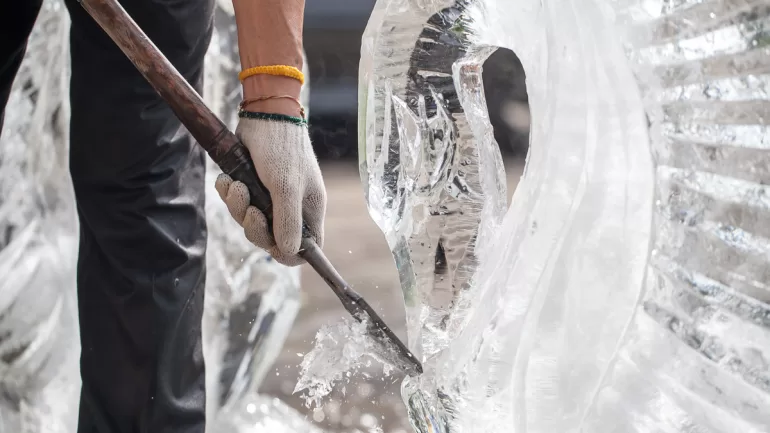ART & DESIGN
Discover expert tips for ice sculpture preservation, from cold tools to humidity control. Learn how ice sculptors keep their work cold and intact.
BY EMMA RADEBAUGH, ARTCENTRON
How Ice Sculptors Keep Their Work Cold and Intact
Ice sculpting is like a high-stakes game of “don’t melt the masterpiece.” When the thermometer climbs, these chilly creations face a ticking clock. Knowing how ice sculptors keep their work cold and intact means understanding a delicate dance of art, science, and a bit of frostbite avoidance. Here’s the cool scoop on what keeps these icy wonders from turning into puddles too soon.
Crafting Techniques That Preserve Integrity
Creating an ice sculpture isn’t just about looking cool; it’s about building something that can survive the heatwave of a summer afternoon. Sculptors start with the finest ice blocks, which are frozen for over 48 to 72 hours to minimize cracks and air bubbles that can weaken the structure. Every cut is a calculated move, balancing detail with durability because no one wants a “meltdown” mid-show.
Sculptors also wield cold tools to stop the metal from warming the ice during carving. Some even chill their chainsaws or chisels beforehand to keep the temperature down during those fine detail cuts.
Speed matters, too; think of it like a figure skater nailing a jump before the music stops. The result is a sculpture tough enough to handle high temperatures.
Optimal Storage and Transport
After carving the masterpiece, it’s off to the ice spa—aka the walk-in freezer. Choosing which type of walk-in freezer doors is right is more than a style choice; it’s about creating a seal so tight that warm air doesn’t sneak in. Doors with magnetic gaskets and insulated cores maintain temperatures as low as minus 10 degrees Fahrenheit, which is critical to preventing surface melting.
Transporting these frozen beauties is a logistical ballet. Insulated blankets protect the sculptures during the short journey from freezer to event, while refrigerated trucks maintain sub-freezing temperatures for longer hauls. Moisture control is a backstage secret, preventing cloudy ice that screams “I’m melting!” louder than you’d want.
Environmental Control at the Display Site
Indoor venues are the VIP lounges of ice sculpture displays—temperature-controlled and humidity-managed, a perfect chill zone. Outdoor setups, though, are where the real drama unfolds.
Shade structures become the sculpture’s best friend, blocking sneaky sun rays, while strategically placed fans and misting systems simulate Arctic breezes, slowing the melting process.
Humidity is the uninvited party crasher that fogs the ice and dulls the sparkle. Keeping humidity below 50 percent is ideal, so artists often deploy portable dehumidifiers, ensuring the sculpture’s icy brilliance shines on.
Keeping It Cool—Final Tip
Heat is the enemy—lights, grills, or a sunbeam sneaking through a window can send a sculpture into a drip frenzy. Placing sculptures at least 10 feet away from any heat source and using LED lighting maintains steady temperatures without sacrificing visual impact.
Knowing how ice sculptors keep their work cold and intact means appreciating the chill strategy behind every glistening curve and frozen flourish. With the right craft, storage, and environment, ice sculptures stay the stars of the show; just don’t forget your mittens.
